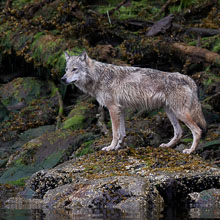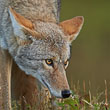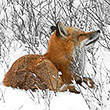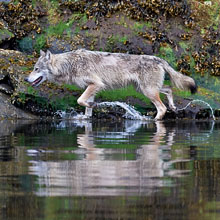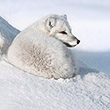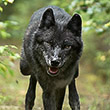Availability: Undetermined - Enquiries?
In the Field
The Sea Wolf. Khutzeymateen Inlet, Great Bear Rainforest, BC, Canada. June 1, 2017.
The Khutzeymateen Inlet - and the entire Great Bear Rainforest - have become world-renown largely because of the conspicuous presence of grizzly bears. But over the last decade or so another top predator of the Great Bear has come "out of the woodwork" and become better known and sought after by wildlife photographers - the coastal gray wolf. But these "sea wolves" are FAR harder to predictably locate and photograph than the grizzlies - which makes capturing shots of them even MORE special!
We were cruising the Khutzeymateen Inlet via sailboat when our incredibly capable skipper and guide (and wildlife spotter extraordinaire!) Chris Tulloch spotted this female gray wolf cruising the shoreline in the distance. The wolf was certainly on a mission - it was headed in our direction at a VERY fast trot and we had no time to waste. We did the "fire-drill thing" and scrambled into our Zodiac so we could try to position ourselves to get some decent shots. We had no idea then that the wolf would virtually ignore us and give us multiple great photo ops as we worked with it along about 4 km of shoreline over the next half hour or so. Even now I'm not sure what I enjoyed more - watching the wolf rapidly weave its way along the shoreline over all sorts of obstacles or the challenge of capturing compelling and well-composed images of the speedy wolf from a moving Zodiac under constantly changing lighting conditions!
During the session I was working two cameras (a Nikon D5 and D500) and two lenses (a Sigma 500mm f4 Sport and a Sigma 120-300mm f2.8 Sport) - and in "both" combinations. As the wolf approached the section of shoreline that had this great rock "perch" on it I quickly moved the 120-300mm f2.8 Sport lens to my D500. I had found this combination of gear (D500 with Sigma 120-300mm f2.8 Sport) to be incredibly useful during my entire stint in the Khutzeymateen this year and thought it would be the perfect choice IF the wolf climbed up on the rock. Well...not only did the wolf climb up, but it decided to take a good 5-10 second break from its mission and look around from the rock and...well...pose almost perfectly! In this particular case the DX "crop-factor" of the D500 gave me the equivalent focal length I wanted (450mm) and the additional depth of field of this gear combination (compared to shooting a Nikon D5 at 450mm) allowed me to shoot with a large aperture (f4) but still have enough DoF to ensure the wolf and the ENTIRE rock perch was tack sharp.
Nikon has long touted the DX "advantage" of their enthusiast and semi-pro DSLR's (though not as much as they did before introducing full-frame FX cameras), i.e., the 50% gain in effective focal length and a corresponding increase in DoF of a little more than a stop (when comparing the effective focal length to a lens giving the same focal length on a FX body). In the low-light world I work in a lot (Canada's coastal rainforest) that DX advantage was rarely realized because of the relatively poor ISO performance of the DX cameras. For me adding a high-quality and fast super-telephoto zoom covering the equivalent focal range of 180mm to 450mm (via the Sigma 120-300mm f2.8 Sport) has allowed me to actually HAVE that DX advantage. Now my D5-D500 combination provides me with the flexibility I had hoped for when then two cameras were announced. Sweet!
Here's a larger (2400 pixel) version of this almost silvery sea wolf:
• The Sea Wolf: Download 2400 pixel image (JPEG: 1.8 MB)
ADDITIONAL NOTES:
1. This image was captured during one of my "Grizzlies of the Khutzeymateen" photo tour in the spring of 2017. Each year I offer trips into two different parts of the Great Bear Rainforest as well as one to photograph aquatic mammals and oceanscapes near the northern tip of Vancouver Island. And, in selected years, I also offer photo tours to locations to capture other highly sought-after subjects, such as various boreal owl species and wildlife of Canada's Arctic. Details about these trips can be found on the Photo Tours page of this website.
2. This image - in all resolutions - is protected by copyright. I'm fine with personal uses of them (including use as desktop backgrounds or screensavers on your own computer), but unauthorized commercial use of the image is prohibited by law. Thanks in advance for respecting my copyright!
3. Like all wildlife photographs on this website, this image was captured following the strict ethical guidelines described in The Wildlife FIRST! Principles of Photographer Conduct. I encourage all wildlife photographers to always put the welfare of their subjects above the value of their photographs.
Behind the Camera
The Sea Wolf. Khutzeymateen Inlet, Great Bear Rainforest, BC, Canada. June 1, 2017.
Digital Capture; Compressed RAW (NEF) 14-bit format; ISO 640.
Nikon D500 paired with Sigma 120-300mm f2.8 Sport lens @ 300mm (for an EFL of 450mm). Hand-held from moving Zodiac. OS on and in "OS1" mode, with OS1 stabilization customized to Moderate View mode; AF customized to Fast Priority AF.
1/1000s @ f4; -1 stop compensation from "recommended" matrix-metered exposure setting.
At the Computer
The Sea Wolf. Khutzeymateen Inlet, Great Bear Rainforest, BC, Canada. June 1, 2017.
RAW Conversion to 16-bit TIFF using Phase One's Capture One Pro 10. Four raw variants (different versions of a single raw capture) processed, with the variants differing in exposure settings (0.8 stop total difference between the variants), shadow recovery and highlight retrieval settings, and colour saturation (with two variants desaturated by a value of -10).
Further digital corrections on resulting 16-bit TIFF files using Adobe's Photoshop CC 2017 and Light Crafts Lightzone. Photoshop adjustments included compositing (blending) of the four output files from the raw converter, minor selective curves (contrast) adjustment, very minor exposure tweaks, and final selective sharpening for web output. Final tone-tweaking performed using LightZone's "tonemapper" tool.
Conservation
The Sea Wolf. Khutzeymateen Inlet, Great Bear Rainforest, BC, Canada. June 1, 2017.
Species Status in Canada*: Only Eastern Wolf listed as species of "Special Concern" in May, 2001. Other populations not listed as Endangered or Threatened.
Species Status in the United States: Western Great Lakes population removed from list of Endangered and Threatened species on January 29, 2007. Proposed delisting of Northern Rockies population on January 29, 2007. Both actions are a direct result of a successful recovery plan. Congratulations! Wolves in other areas of the lower 48 states (including the Southwest wolf population), remain on Endangered Species list.
Probably no species alive today has suffered as much direct persecution from humans as has the Gray Wolf (Canis lupus). Once extremely widespread in North America, the Gray Wolf was virtually extirpated from the contiguous 48 states of America and now is regularly found within only a fraction of its historical range in Canada. While the Gray Wolf is currently listed as endangered in most of the 48 lower states of the United States and enjoys the privileges associated with such status (if lack of persecution and abuse can be thought of as a privilege), it is still official policy in much of Canada to rid the countryside of this magnificent keystone predator. As an example, in British Columbia, there is NO closed season on the wolf in most hunting jurisdictions and opportunistic slaughter is encouraged by policy (it is the ONLY fur-bearing species for which NO hunting license is required in British Columbia!). Conservation of wolves presents a puzzling paradox. Reduced to the most basic principles, wolf conservation is simplistic: we need only to stop persecuting this species in order for it to survive. Yet accomplishing this invariably proves incredibly difficult - it's as though wolf persecution has been institutionalized directly into government (and societal) bureaucracy.
*as determined by COSEWIC: The Committee on the Status of Endangered Wildlife in Canada



















